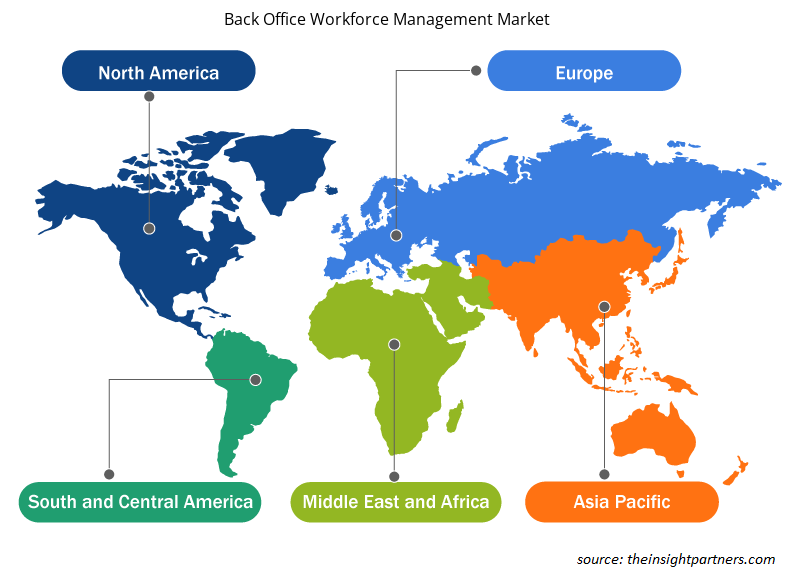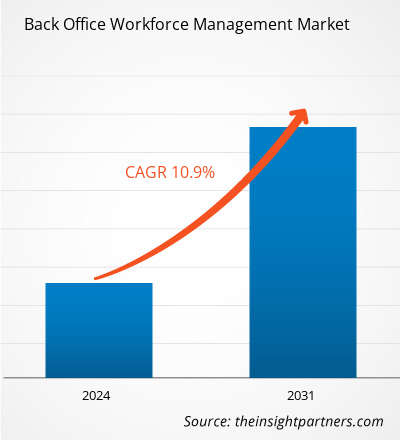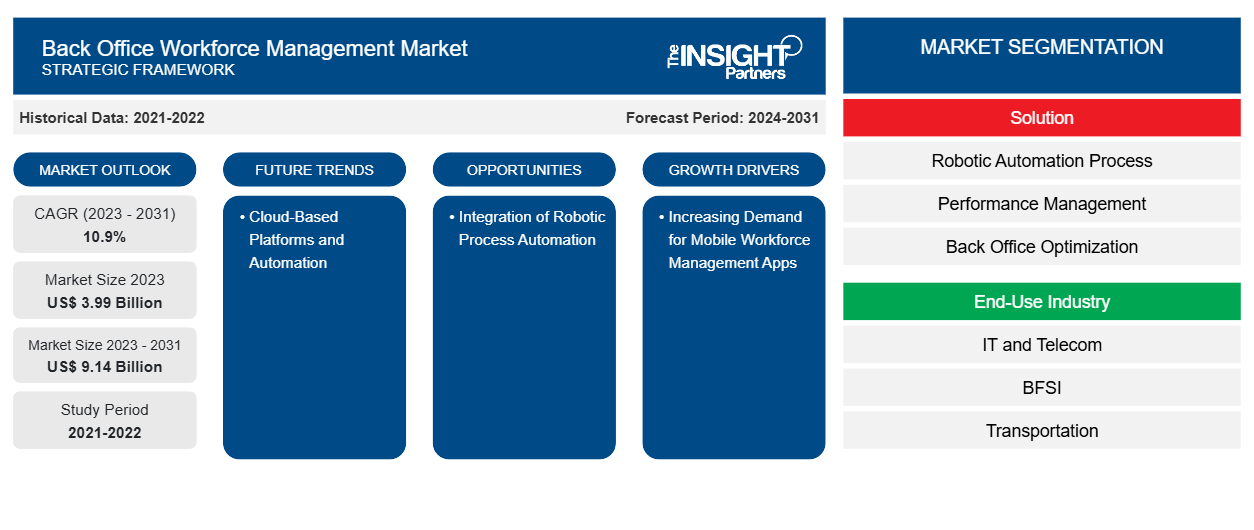من المتوقع أن يصل حجم سوق إدارة القوى العاملة في المكاتب الخلفية إلى 9.14 مليار دولار أمريكي بحلول عام 2031 من 3.99 مليار دولار أمريكي في عام 2023. ومن المتوقع أن يسجل السوق معدل نمو سنوي مركب بنسبة 10.9٪ خلال الفترة 2023-2031. ومن المرجح أن تظل المنصات القائمة على السحابة والأتمتة اتجاهًا رئيسيًا في السوق.
تحليل سوق إدارة القوى العاملة في المكاتب الخلفية
إن سوق إدارة القوى العاملة في المكاتب الخلفية مدفوع بالحاجة إلى تحسين القوى العاملة، وزيادة نشر السحابة، والامتثال الأعلى للتفويضات التنظيمية المختلفة. والأهم من ذلك، أن الوباء أثر بشكل كبير على هذا السوق من خلال تسريع تبني ترتيبات العمل عن بعد والمرنة وزيادة الطلب بشكل كبير على الحلول التي تسمح بالعمل عن بعد. يعمل المشاركون الرئيسيون في السوق وتبني وسائل شفافة ومبررة لأنظمة مراقبة الموظفين كمحركات رئيسية للنمو. كما تعمل معايير إدارة القوى العاملة المحسنة مع دمج التقنيات الجديدة مثل إنترنت الأشياء والذكاء الاصطناعي على ضخ السوق.
نظرة عامة على سوق إدارة القوى العاملة في المكاتب الخلفية
تشير إدارة القوى العاملة في المكتب الخلفي إلى إدارة وتنسيق العمليات التجارية الداخلية غير المرتبطة مباشرة بالعملاء. وهي تشمل وظائف ضخمة مثل المحاسبة وإدارة المخزون وإدارة سلسلة التوريد والموارد البشرية والخدمات اللوجستية وخدمات تكنولوجيا المعلومات، من بين العديد من الوظائف الأخرى. يلعب المكتب الخلفي دورًا أساسيًا في دعم أهداف فريق المكتب الأمامي من خلال التعامل مع الأنشطة المتعلقة بالإدارة وصيانة السجلات وإدارة البيانات وما إلى ذلك. قد يتضمن أيضًا إدارة فعالة للموارد والتكنولوجيا والخدمات لضمان التدفق السليم للعمليات الداخلية للمنظمة. يعد المكتب الخلفي مهمًا لتحسين عبء العمل ورضا العملاء والموظفين، وأخيرًا، دفع التحسينات في العمليات.
قم بتخصيص هذا التقرير ليناسب متطلباتك
ستحصل على تخصيص لأي تقرير - مجانًا - بما في ذلك أجزاء من هذا التقرير، أو تحليل على مستوى الدولة، وحزمة بيانات Excel، بالإضافة إلى الاستفادة من العروض والخصومات الرائعة للشركات الناشئة والجامعات
-
احصل على أهم اتجاهات السوق الرئيسية لهذا التقرير.ستتضمن هذه العينة المجانية تحليلاً للبيانات، بدءًا من اتجاهات السوق وحتى التقديرات والتوقعات.
محركات وفرص سوق إدارة القوى العاملة في المكاتب الخلفية
تزايد الطلب على تطبيقات إدارة القوى العاملة عبر الهاتف المحمول
تتطلع الشركات بشكل متزايد إلى حلول قائمة على التطبيقات لإدارة القوى العاملة في المكاتب الخلفية بهدف إنشاء بيئات عمل ذكية. إن الخوف من استيعاب فوائد التنقل سيكلف الكثير على المدى الطويل بسبب عدم الكفاءة التي قد تنتج. في هذا الصدد، يمكن استخدام تطبيق الهاتف المحمول لتوفير منصة واحدة في مركز إنشاء تجربة متسقة عبر قاعدة الموظفين المتصلة. يتيح مراقبة الموقع للمؤسسات تقديم محتوى ذي صلة وإشعارات في الوقت الفعلي عبر القوى العاملة لإنشاء تجارب في الوقت المناسب وذات صلة تضمن الكفاءة والإنتاجية ومشاركة الموظفين. تسهل التطبيقات المحمولة تسجيل أيام العمل الرسمية وجميع التفاصيل الأخرى يدويًا في نظام البيانات. إنه يعمل كمكان واحد يمكن من خلاله دمج جميع نقاط الاتصال الرقمية المشاركة في إدارة القوى العاملة بسلاسة. من ناحية أخرى، يتيح دمج الأصول المتعلقة بالعمل في تطبيق واحد للمؤسسة إدارة العمل السلس للموظفين داخل مكان العمل أو خارجه وكذلك التواصل والتعاون مع فرق الإدارة وزملاء العمل. إن المستوى المتزايد من الاعتراف فيما يتعلق بمزايا حلول التطبيقات المحمولة لإدارة القوى العاملة يخلق فرصًا للاعبين في سوق إدارة القوى العاملة في المكاتب الخلفية.
دمج أتمتة العمليات الروبوتية
من بين الاتجاهات الرئيسية التي من المرجح أن يشهدها السوق دمج أتمتة العمليات الروبوتية في حلول إدارة القوى العاملة في المكاتب الخلفية. يتم تعريف RPA على أنه آلية تقترح الحصول على عدد أكبر من المهام التشغيلية بواسطة الروبوتات، مما يزيد بدوره من الكفاءة والإنتاجية ومشاركة الموظفين. إن الموجة الجديدة من الطلب على أتمتة مسؤوليات القوى العاملة هي فرصة ممتازة للاعبين المشاركين في هذه الصناعة. يمكن استخدامها لتعزيز قدراتها في تلبية احتياجات الشركات الجديدة التي تتطلع إلى تحسين العمليات التشغيلية وأداء الموظفين.
تقرير تحليل تجزئة سوق إدارة القوى العاملة في المكاتب الخلفية
إن القطاعات الرئيسية التي ساهمت في استخلاص تحليل سوق إدارة القوى العاملة في المكاتب الخلفية هي صناعة الحلول والاستخدام النهائي.
- بناءً على الحل، ينقسم السوق إلى عملية الأتمتة الروبوتية، وإدارة الأداء، وتحسين المكتب الخلفي، وتحليلات العمليات، وغيرها. احتل قطاع إدارة الأداء حصة سوقية كبيرة في عام 2023.
- بناءً على صناعة الاستخدام النهائي، يتم تقسيم السوق إلى تكنولوجيا المعلومات والاتصالات، والخدمات المصرفية والمالية والتأمين، والنقل، والتجزئة والتجارة الإلكترونية، والحكومة، وغيرها. احتل قطاع الخدمات المصرفية والمالية والتأمين حصة سوقية كبيرة في عام 2023.
تحليل حصة سوق إدارة القوى العاملة في المكاتب الخلفية حسب المنطقة الجغرافية
ينقسم النطاق الجغرافي لتقرير سوق إدارة القوى العاملة في المكاتب الخلفية بشكل أساسي إلى خمس مناطق: أمريكا الشمالية، ومنطقة آسيا والمحيط الهادئ، وأوروبا، والشرق الأوسط وأفريقيا، وأمريكا الجنوبية والوسطى.
في أمريكا الشمالية، تبرز الولايات المتحدة كسوق بالغة الأهمية، حيث يوجد عدد كبير من شركات فورتشن 500 التي تتخذ من البلاد مقراً لها، مما يدفع الطلب على حلول إدارة القوى العاملة في المكاتب الخلفية. ويتزايد اعتماد حلول إدارة القوى العاملة المستندة إلى السحابة استجابة للانتشار المتزايد لترتيبات العمل عن بعد، مما يتيح للمؤسسات مراقبة ساعات العمل وإنتاجية الموظفين الذين يعملون من مواقع متنوعة بشكل فعال.
رؤى إقليمية حول سوق إدارة القوى العاملة في المكاتب الخلفية
لقد قام المحللون في Insight Partners بشرح الاتجاهات والعوامل الإقليمية المؤثرة على سوق إدارة القوى العاملة في المكاتب الخلفية طوال فترة التوقعات بشكل شامل. يناقش هذا القسم أيضًا قطاعات سوق إدارة القوى العاملة في المكاتب الخلفية والجغرافيا في جميع أنحاء أمريكا الشمالية وأوروبا ومنطقة آسيا والمحيط الهادئ والشرق الأوسط وأفريقيا وأمريكا الجنوبية والوسطى.

- احصل على البيانات الإقليمية المحددة لسوق إدارة القوى العاملة في المكاتب الخلفية
نطاق تقرير سوق إدارة القوى العاملة في المكاتب الخلفية
| سمة التقرير | تفاصيل |
|---|---|
| حجم السوق في عام 2023 | 3.99 مليار دولار أمريكي |
| حجم السوق بحلول عام 2031 | 9.14 مليار دولار أمريكي |
| معدل النمو السنوي المركب العالمي (2023 - 2031) | 10.9% |
| البيانات التاريخية | 2021-2022 |
| فترة التنبؤ | 2024-2031 |
| القطاعات المغطاة |
حسب الحل
|
| المناطق والدول المغطاة |
أمريكا الشمالية
|
| قادة السوق وملفات تعريف الشركات الرئيسية |
|
كثافة اللاعبين في سوق إدارة القوى العاملة في المكاتب الخلفية: فهم تأثيرها على ديناميكيات الأعمال
يشهد سوق إدارة القوى العاملة في المكاتب الخلفية نموًا سريعًا، مدفوعًا بالطلب المتزايد من المستخدم النهائي بسبب عوامل مثل تفضيلات المستهلكين المتطورة والتقدم التكنولوجي والوعي الأكبر بفوائد المنتج. ومع ارتفاع الطلب، تعمل الشركات على توسيع عروضها والابتكار لتلبية احتياجات المستهلكين والاستفادة من الاتجاهات الناشئة، مما يؤدي إلى زيادة نمو السوق.
تشير كثافة اللاعبين في السوق إلى توزيع الشركات أو المؤسسات العاملة في سوق أو صناعة معينة. وهي تشير إلى عدد المنافسين (اللاعبين في السوق) الموجودين في مساحة سوق معينة نسبة إلى حجمها أو قيمتها السوقية الإجمالية.
الشركات الرئيسية العاملة في سوق إدارة القوى العاملة المكتبية الخلفية هي:
- شركة نيس المحدودة
- شركة النصوص المفتوحة
- شركة أوراكل
- جينيسيس
- شركة ألفاريا
- شركة فيرينت سيستمز
إخلاء المسؤولية : الشركات المذكورة أعلاه ليست مرتبة بأي ترتيب معين.

- احصل على نظرة عامة على أهم اللاعبين الرئيسيين في سوق إدارة القوى العاملة في المكاتب الخلفية
أخبار سوق إدارة القوى العاملة في المكاتب الخلفية والتطورات الأخيرة
يتم تقييم سوق إدارة القوى العاملة في المكاتب الخلفية من خلال جمع البيانات النوعية والكمية بعد البحث الأولي والثانوي، والذي يتضمن منشورات الشركات المهمة وبيانات الجمعيات وقواعد البيانات. فيما يلي بعض التطورات في سوق إدارة القوى العاملة في المكاتب الخلفية:
- أعلنت شركة Zapier، منصة أتمتة سير العمل للشركات الصغيرة والمتوسطة الحجم، أنها استحوذت على الفريق الذي يقف وراء Vowel، أداة مؤتمرات الفيديو المدعومة بالذكاء الاصطناعي، مقابل مبلغ لم يتم الكشف عنه. سيصبح الرئيس التنفيذي لشركة Vowel، أندرو بيرمان، مدير الذكاء الاصطناعي الجديد في Zapier. ومن خلال هذا الاستحواذ، سيركز فريق Vowel على تعزيز قدرات أتمتة الذكاء الاصطناعي في Zapier.
(المصدر: Inter Zapier Inc.، موقع الشركة الإلكتروني، مارس 2024)
تقرير سوق إدارة القوى العاملة في المكاتب الخلفية والتغطية والنتائج المتوقعة
يوفر تقرير "حجم سوق إدارة القوى العاملة في المكاتب الخلفية والتوقعات (2021-2031)" تحليلاً مفصلاً للسوق يغطي المجالات التالية:
- حجم سوق إدارة القوى العاملة في المكاتب الخلفية وتوقعاتها على المستويات العالمية والإقليمية والوطنية لجميع قطاعات السوق الرئيسية التي يغطيها النطاق
- اتجاهات سوق إدارة القوى العاملة في المكاتب الخلفية، بالإضافة إلى ديناميكيات السوق مثل المحركات والقيود والفرص الرئيسية
- تحليل مفصل لقوى PEST/Porter الخمس وSWOT
- تحليل سوق إدارة القوى العاملة في المكاتب الخلفية يغطي اتجاهات السوق الرئيسية والإطار العالمي والإقليمي والجهات الفاعلة الرئيسية واللوائح والتطورات الأخيرة في السوق
- تحليل المشهد الصناعي والمنافسة الذي يغطي تركيز السوق، وتحليل خريطة الحرارة، واللاعبين البارزين، والتطورات الأخيرة في سوق إدارة القوى العاملة في المكاتب الخلفية
- ملفات تعريف الشركة التفصيلية
- التحليل التاريخي (سنتان)، سنة الأساس، التوقعات (7 سنوات) مع معدل النمو السنوي المركب
- تحليل PEST و SWOT
- حجم السوق والقيمة / الحجم - عالمي، إقليمي، بلد
- الصناعة والمنافسة
- مجموعة بيانات إكسل
التقارير الحديثة
تقارير ذات صلة
شهادات العملاء
سبب الشراء
- اتخاذ قرارات مدروسة
- فهم ديناميكيات السوق
- تحليل المنافسة
- رؤى العملاء
- توقعات السوق
- تخفيف المخاطر
- التخطيط الاستراتيجي
- مبررات الاستثمار
- تحديد الأسواق الناشئة
- تحسين استراتيجيات التسويق
- تعزيز الكفاءة التشغيلية
- مواكبة التوجهات التنظيمية























 احصل على عينة مجانية ل - سوق إدارة القوى العاملة في المكاتب الخلفية
احصل على عينة مجانية ل - سوق إدارة القوى العاملة في المكاتب الخلفية